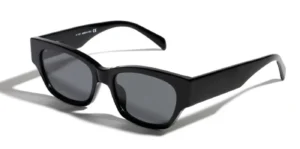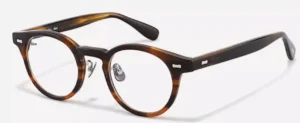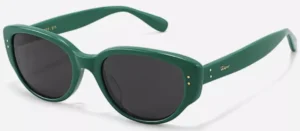Have you ever heard of what polarized sunglasses are? Let’s learn together with a custom sunglasses manufacturer‘s explanation. Polarized sunglasses are a type of sunglasses with three types of polarization: linear, elliptical, and circular. Linear polarization, also known as plane polarization, is the most common.

It has a fixed vibration direction and a sine wave propagation path. Its straight line projection is perpendicular to the propagation direction. Passing natural light through a polarizing filter produces linearly polarized light. This type of light is frequently used in studying crystal optics.
This guide is also suitable for custom eyewear manufacturers working on designing sunglasses.
1. Definition of Polarized Sunglasses
Polarized light is also known as polarized radiation. Visible light is a transverse wave with vibration direction perpendicular to the propagation direction. The vibration direction of natural light is arbitrary within the plane perpendicular to the propagation direction. For polarized light, its vibration direction is restricted to a specific direction at a given moment.
2. Functions of Polarized Sunglasses
Many light sources, especially sunlight, emit harmful radiation, including visible light, infrared, and ultraviolet (UV) radiation. UV radiation can cause serious damage to skin and eyes. Visible light ranges from 380 to 780 nm, while UV radiation is divided into UVA, UVB, and UVC, with the latter being the most harmful. Prolonged exposure to UVB can seriously affect vision and cause skin damage.

Polarized sunglasses can block harmful radiation while allowing visible light to pass through. They can also reduce glare, reflections, and water surface glitter, making them ideal for driving, fishing, and daily wear.
3. How Polarized Lenses Work
Polarized sunglasses can block uncomfortable glare and protect eyes from harmful UV radiation thanks to metal powder filters that selectively absorb certain wavelengths of light. When light passes through the lens, interference occurs due to overlapping waves, causing some wavelengths to cancel out. This phenomenon depends on the lens’s refractive index and thickness. The refractive index varies depending on the lens’s chemical composition, while the thickness remains relatively constant.

Polarized sunglasses offer another mechanism for protecting eyes from glare, especially from the unique polarized light reflected off asphalt roads. Regular light consists of randomly vibrating waves, while polarized light consists of waves vibrating in a single direction.

Polarized lenses can effectively filter out this ordered light by only allowing waves vibrating in a certain direction to pass through. This “combs” the light and reduces transmission of light waves vibrating parallel to the road surface. The filtering layer of the lens is oriented horizontally to absorb horizontally polarized light and eliminate most of the reflected glare while maintaining the overall brightness of the environment.
4. How to tell if sunglasses are polarized
Polarized sunglasses are made using the crystal alignment principle of the lens, which only allows waves vibrating in a specific direction to pass through while blocking waves vibrating in other directions, similar to how a Venetian blind works.
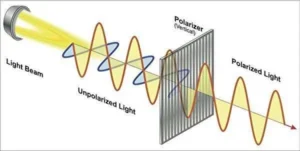
Using this principle, polarized sunglasses can effectively eliminate and filter polarized light from the beam, allowing light to enter the eye along the correct optical axis, enhancing contrast, reducing glare, increasing color saturation, and reducing atmospheric haze.
So, what makes a good pair of polarized sunglasses? And how can you easily distinguish between real and fake polarized sunglasses?
(4.1) Feature identification method:
Look for functionality. Good polarized sunglasses can filter out 99% of glare, harmful UV radiation, and are durable. They have a special vertical coating on the lens to filter out equally intense light reflected from water, land, or snow.
(4.2)Experimental method: Look at the color.
To test whether sunglasses are polarized, hold them horizontally in front of an LCD screen. There should be no change in the lens. Then rotate the sunglasses 45 degrees clockwise.

If the lens appears to darken and then return to normal as you rotate the sunglasses, they are polarized. If there is no change no matter how you rotate them, they are not polarized. (Note: make sure to use an LCD screen for this test.)

(4.3)Smartphone method: Look at the screen.
First, open a colored photo on your phone. Second, hold the sunglasses up to the phone screen without moving it. Third, rotate the sunglasses parallel to the phone screen. Fourth, observe the changes in the photo through the lens. If the photo appears to flicker or become darker and lighter, the sunglasses are polarized.

Both polarized and regular sunglasses provide UV protection and reduce brightness, but regular sunglasses do not polarize or convert light. This is the main difference between the two types of sunglasses, and regular sunglasses are generally cheaper than polarized ones.
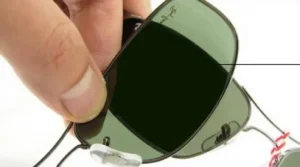
In fact, the difference between polarized and regular sunglasses and how to distinguish them is relatively simple. Just stack two polarized lenses perpendicularly, and if they don’t let any light through, they are real polarized lenses. This is because the special design of polarized lenses only allows parallel light to pass through the lens, so when two lenses are stacked perpendicularly, most of the light is blocked.
5. Polarized vs tinted sunglasses
The differences between polarized and tinted sunglasses are:
Different definitions: polarized lenses are made based on the polarization principle of light, while sun lenses are designed to block strong light and reduce UV radiation.
Different functions: polarized lenses filter out direct light to make the view clearer, while sun lenses reduce the damage caused by light exposure.
Different principles: polarized lenses use the polarization principle and do not change the color of objects, while sun lenses block light using colored dyes that can change the color of objects.
Different materials: polarized lenses are made by laminating polarizing film, while sun lenses are made of optical glass.

Different uses: polarized lenses are used for sunglasses and camera lenses, while sun lenses are used for sun visors, light-colored lenses, and special-purpose sunglasses.
Different levels of protection: polarized lenses can completely block glare and provide true eye protection, while sun lenses cannot avoid the damage caused by glare.
Different levels of UV protection: polarized lenses have a UV blocking rate of 99%, while tinted sun lenses have a relatively low blocking rate.
Types of sun lenses: anti-reflective lenses, colored lenses, tinted lenses, polarized lenses, and photochromic lenses.
To buy high-quality sunglasses, it’s best to go to a professional optical or eyewear store.
6. When to Use Polarized Glasses
In summer, anglers like to wear polarized sunglasses because they filter out polarized light and make it easier to see the float without eye strain. Dark-colored lenses like brown and green-grey are more comfortable to wear in summer.
Polarized lenses are considered the best for driving, as they reduce the glare from reflected light, which can cause eye fatigue and make objects appear blurry. They filter out scattered light, improve visibility, and enhance driving pleasure.

Outdoor enthusiasts also appreciate polarized lenses, which are made of balanced crystals that only allow light waves vibrating in a certain direction to pass through. This reduces reflections from surfaces like water, glass, and foliage, enhancing contrast, reducing glare, and intensifying colors.
Polarized lenses are professionally designed to avoid distortion and dizzying effects, and resin polarized lenses are lightweight and shatter-resistant. They are ideal for fishing, driving, sports, sailing, skiing, hunting, and other outdoor activities.
7. Disadvantages of Polarized Sunglasses
Although polarized spectacle lenses can filter out a lot of irregular light effects and prevent glare and glare, if the arc of the spectacle lens itself cannot be in the standard refraction state of electron optics, the actual effect of polarized light will be weakened, affecting the real and effective images, causing visual distortion and affecting the visual experience. Polarized lenses may cause dizziness, vertigo and other discomfort, and the durability is not good.
8. Summary of What Are Polarized Sunglasses
Do you now know what polarized sunglasses are? How to tell if sunglasses are polarized ? However, for people who generally do not have high requirements, ordinary sunglasses can be used, because polarized sunglasses are relatively high-end sunglasses. Of course, if you are a car owner who needs to drive, it is better to wear polarized sunglasses when driving, because you often encounter various glare when driving. Polarized sunglasses can not only block part of the glare, but also filter out the strong light reflected from the ground or the opposite car body, so as to make the field of vision clearer, reduce visual fatigue, and facilitate safe driving.
